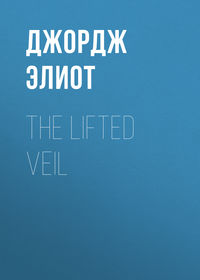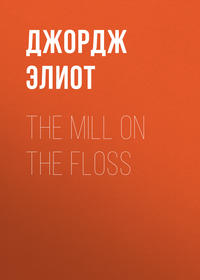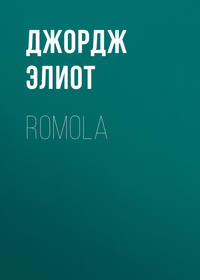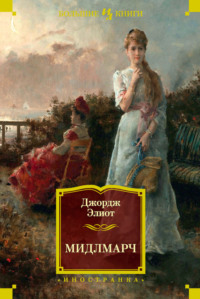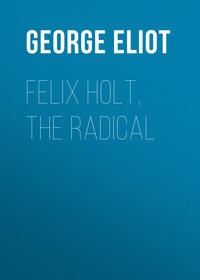 полная версия
полная версияGeorge Eliot's Life, as Related in Her Letters and Journals. Vol. 2 (of 3)
Andrea del Sarto is seen to advantage at the Pitti Palace; but his chef-d'œuvre is a fresco, unhappily much worn – the Madonna del Sacco – in the cloister of the Annunziata.
For early Florentine paintings the most interesting collection is that of the Accademia. Here we saw a Cimabue, which gave us the best idea of his superiority over the painters who went before him: it is a colossal Madonna enthroned. And on the same wall there is a colossal Madonna by Giotto, which is not only a demonstration that he surpassed his master, but that he had a clear vision of the noble in art. A delightful picture – very much restored, I fear – of the Adoration of the Magi made me acquainted with Gentile da Fabriano. The head of Joseph in this picture is masterly in the delicate rendering of the expression; the three kings are very beautiful in conception; and the attendant group, or rather crowd, shows a remarkable combination of realism with love of the beautiful and splendid.
There is a fine Domenico Ghirlandajo – the Adoration of the Shepherds; a fine Lippo Lippi; and an Assumption, by Perugino, which I like well for its cherubs and angels, and for some of the adoring figures below. In the smaller room there is a lovely Pietà by Fra Angelico; and there is a portrait of Fra Angelico himself by another artist.
One of our drives at Florence, which I have not mentioned, was that to Galileo's Tower, which stands conspicuous on one of the hills close about the town. We ascended it for the sake of looking out over the plain from the same spot as the great man looked from, more than two centuries ago. His portrait is in the Pitti Palace – a grave man with an abbreviated nose, not unlike Mr. Thomas Adolphus Trollope.
One fine day near the end of our stay we made an expedition to Siena – that fine old town built on an abrupt height overlooking a wide, wide plain. We drove about a couple of hours or more, and saw well the exterior of the place – the peculiar piazza or campo in the shape of a scallop-shell, with its large old Palazzo publico, the Porta Ovile and Porta Romana, the archbishop's palace, and the cemetery. Of the churches we saw only the cathedral, the Chapel of St. John the Baptist, and San Domenico. The cathedral has a highly elaborate Gothic façade, but the details of the upper part are unsatisfactory – a square window in the centre shocks the eye, and the gables are not slim and aspiring enough. The interior is full of interest: there is the unique pavement in a sort of marble Niello, presenting Raffaellesque designs by Boccafumi, carrying out the example of the older portions, which are very quaint in their drawing; there is a picture of high interest in the history of early art – a picture by Guido of Siena, who was rather earlier than Cimabue; fine carved stalls and screens in dark wood; and in an adjoining chapel a series of frescoes by Pinturicchio, to which Raphael is said to have contributed designs and workmanship, and wonderfully illuminated old choir-books. The Chapel of St. John the Baptist has a remarkable Gothic façade, and a baptismal font inside, with reliefs wrought by Ghiberti and another Florentine artist. To San Domenico we went for the sake of seeing the famous Madonna by Guido da Siena; I think we held it superior to any Cimabue we had seen. There is a considerable collection of the Siennese artists at the Accademia, but the school had no great genius equal to Giotto to lead it. The Three Graces – an antique to which Canova's modern triad bears a strong resemblance in attitude and style – are also at the Accademia.
An interesting visit we made at Florence was to Michael Angelo's house – Casa Buonarotti – in the Via Ghibellina. This street is striking and characteristic: the houses are all old, with broad eaves, and in some cases with an open upper story, so that the roof forms a sort of pavilion supported on pillars. This is a feature one sees in many parts of Florence. Michael Angelo's house is preserved with great care by his descendants – only one could wish their care had not been shown in giving it entirely new furniture. However, the rooms are the same as those he occupied, and there are many relics of his presence there – his stick, his sword, and many of his drawings. In one room there is a very fine Titian of small size – the principal figure a woman fainting.
The Last Supper – a fresco believed to be by Raphael – is in a room at the Egyptian Museum.19 The figure of Peter – of which, apparently, there exists various sketches by Raphael's hand – is memorable.
Letter to John Blackwood, 18th May, 1860.
Things really look so threatening in the Neapolitan kingdom that we begin to think ourselves fortunate in having got our visit done. Tuscany is in the highest political spirits for the moment, and of course Victor Emanuel stares at us at every turn here, with the most loyal exaggeration of mustache and intelligent meaning. But we are selfishly careless about dynasties just now, caring more for the doings of Giotto and Brunelleschi than for those of Count Cavour. On a first journey to the greatest centres of art one must be excused for letting one's public spirit go to sleep a little. As for me, I am thrown into a state of humiliating passivity by the sight of the great things done in the far past – it seems as if life were not long enough to learn, and as if my own activity were so completely dwarfed by comparison that I should never have courage for more creation of my own. There is only one thing that has an opposite and stimulating effect: it is the comparative rarity, even here, of great and truthful art, and the abundance of wretched imitation and falsity. Every hand is wanted in the world that can do a little genuine, sincere work.
We are at the quietest hotel in Florence, having sought it out for the sake of getting clear of the stream of English and Americans, in which one finds one's self in all the main tracks of travel, so that one seems at last to be in a perpetual, noisy picnic, obliged to be civil, though with a strong inclination to be sullen. My philanthropy rises several degrees as soon as we are alone.
Letter to Major Blackwood, 27th May, 1860.
I am much obliged to you for writing at once, and so scattering some clouds which had gathered over my mind in consequence of an indication or two in Mr. John Blackwood's previous letter. The Times article arrived on Sunday. It is written in a generous spirit, and with so high a degree of intelligence that I am rather alarmed lest the misapprehensions it exhibits should be due to my defective presentation, rather than to any failure on the part of the critic. I have certainly fulfilled my intention very badly if I have made the Dodson honesty appear "mean and uninteresting," or made the payment of one's debts appear a contemptible virtue in comparison with any sort of "Bohemian" qualities. So far as my own feeling and intention are concerned, no one class of persons or form of character is held up to reprobation or to exclusive admiration. Tom is painted with as much love and pity as Maggie; and I am so far from hating the Dodsons myself that I am rather aghast to find them ticketed with such very ugly adjectives. We intend to leave this place on Friday (3d), and in four days after that we shall be at Venice, in a few days from that time at Milan, and then, by a route at present uncertain, at Berne, where we take up Mr. Lewes's eldest boy, to bring him home with us.
We are particularly happy in our weather, which is unvaryingly fine without excessive heat. There has been a crescendo of enjoyment in our travels; for Florence, from its relation to the history of modern art, has roused a keener interest in us even than Rome, and has stimulated me to entertain rather an ambitious project, which I mean to be a secret from every one but you and Mr. John Blackwood.
Any news of "Clerical Scenes" in its third edition? Or has its appearance been deferred? The smallest details are acceptable to ignorant travellers. We are wondering what was the last good article in Blackwood, and whether Thackeray has gathered up his slack reins in the Cornhill. Literature travels slowly even to this Italian Athens. Hawthorne's book is not to be found here yet in the Tauchnitz edition.
Italy, 1860.
We left Florence on the evening of the 1st of June, by diligence, travelling all night and until eleven the next morning to get to Bologna. I wish we could have made that journey across the Apennines by daylight, though in that case I should have missed certain grand, startling effects that came to me in my occasional wakings. Wonderful heights and depths I saw on each side of us by the fading light of the evening. Then, in the middle of the night, while the lightning was flashing and the sky was heavy with threatening storm-clouds, I waked to find the six horses resolutely refusing or unable to move the diligence – till, at last, two meek oxen were tied to the axle, and their added strength dragged us up the hill. But one of the strangest effects I ever saw was just before dawn, when we seemed to be high up on mighty mountains, which fell precipitously, and showed us the awful, pale horizon far, far below.
The first thing we did at Bologna was to go to the Accademia, where I confirmed myself in my utter dislike of the Bolognese school – the Caraccis and Domenichino et id genus omne– and felt some disappointment in Raphael's St. Cecilia. The pictures of Francia here, to which I had looked forward as likely to give me a fuller and higher idea of him, were less pleasing to me than the smaller specimens of him that I had seen in the Dresden and other galleries. He seems to me to be more limited even than Perugino; but he is a faithful, painstaking painter, with a religious spirit. Agostino Caracci's Communion of St. Jerome is a remarkable picture, with real feeling in it – an exception among all the great pieces of canvas that hang beside it. Domenichino's figure of St. Jerome is a direct plagiarism from that of Agostino; but in other points the two pictures are quite diverse.
The following morning we took a carriage and were diligent in visiting the churches. San Petronio has the melancholy distinction of an exquisite Gothic façade, which is carried up only a little way above the arches of the doorways; the sculptures on these arches are of wonderful beauty. The interior is of lofty, airy, simple Gothic, and it contains some curious old paintings in the various side-chapels – pre-eminent among which are the great frescoes by the so-called Buffalmacco. The Paradise is distinguished in my memory by the fact that the blessed are ranged in seats like the benches of a church or chapel. At Santa Cecilia – now used as a barrack or guard-room – there are two frescoes by Francia, the Marriage and Burial of St. Cecilia, characteristic, but miserably injured. At the great Church of San Domenico the object of chief interest is the tomb of the said saint, by the ever-to-be-honored Nicolo Pisano. I believe this tomb was his first great work, and very remarkable it is; but there is nothing on it equal to the Nativity on the pulpit at Pisa. On this tomb stands a lovely angel, by Michael Angelo. It is small in size, holding a small candle-stick, and is a work of his youth; it shows clearly enough how the feeling for grace and beauty were strong in him, only not strong enough to wrestle with his love of the grandiose and powerful.
The ugly, painful leaning towers of Bologna made me desire not to look at them a second time; but there are fine bits of massive palatial building here and there in the colonnaded streets. We trod the court of the once famous university, where the arms of the various scholars ornament the walls above and below an interior gallery. This building is now, as far as I could understand, a communal school, and the university is transported to another part of the town.
We left Bologna in the afternoon, rested at Ferrara for the night, and passed the Euganean Mountains on our left hand as we approached Padua in the middle of the next day.
After dinner and rest from our dusty journeying we took a carriage and went out to see the town, desiring most of all to see Giotto's Chapel. We paused first, however, at the great Church of San Antonio, which is remarkable both externally and internally. There are two side chapels opposite each other, which are quite unique for contrasted effect. On the one hand is a chapel of oblong form, covered entirely with white marble relievi, golden lamps hanging from the roof; while opposite is a chapel of the same form, covered with frescoes by Avanzi, the artist who seems to have been the link of genius between Giotto and Masaccio. Close by, in a separate building, is the Capella di San Giorgio, also covered with Avanzi's frescoes; and here one may study him more completely, because the light is better than in the church. He has quite a Veronese power of combining his human groups with splendid architecture.
The Arena Chapel stands apart, and is approached, at present, through a pretty garden. Here one is uninterruptedly with Giotto. The whole chapel was designed and painted by himself alone; and it is said that, while he was at work on it, Dante lodged with him at Padua. The nave of the chapel is in tolerably good preservation, but the apsis has suffered severely from damp. It is in this apsis that the lovely Madonna, with the Infant at her breast, is painted in a niche, now quite hidden by some altar-piece or woodwork, which one has to push by in order to see the tenderest bit of Giotto's painting. This chapel must have been a blessed vision when it was fresh from Giotto's hand – the blue, vaulted roof; the exquisite bands of which he was so fond, representing inlaid marble, uniting roof and walls, and forming the divisions between the various frescoes which cover the upper part of the wall. The glory of Paradise at one end, and the histories of Mary and Jesus on the two sides; and the subdued effect of the series of monochromes representing the Virtues and Vices below.
There is a piazza with a plantation and circular public walk, with wildly affected statues of small and great notorieties, which remains with one as a peculiarity of Padua; in general the town is merely old and shabbily Italian, without anything very specific in its aspect.
From Padua to Venice!
It was about ten o'clock on a moonlight night – the 4th of June – that we found ourselves apparently on a railway in the midst of the sea; we were on the bridge across the Lagoon. Soon we were in a gondola on the Grand Canal, looking out at the moonlit buildings and water. What stillness! What beauty! Looking out from the high window of our hotel on the Grand Canal I felt that it was a pity to go to bed. Venice was more beautiful than romances had feigned.
And that was the impression that remained, and even deepened, during our stay of eight days. That quiet which seems the deeper because one hears the delicious dip of the oar (when not disturbed by clamorous church bells) leaves the eye in full liberty and strength to take in the exhaustless loveliness of color and form.
We were in our gondola by nine o'clock the next morning, and, of course, the first point we sought was the Piazza di San Marco. I am glad to find Ruskin calling the Palace of the Doges one of the two most perfect buildings in the world; its only defects, to my feeling, are the feebleness or triviality of the frieze or cornice, and the want of length in the Gothic windows with which the upper wall is pierced. This spot is a focus of architectural wonders; but the palace is the crown of them all. The double tier of columns and arches, with the rich sombreness of their finely outlined shadows, contrast satisfactorily with the warmth and light and more continuous surface of the upper part. Even landing on the Piazzetta, one has a sense, not only of being in an entirely novel scene, but one where the ideas of a foreign race have poured themselves in without yet mingling indistinguishably with the pre-existent Italian life. But this is felt yet more strongly when one has passed along the Piazzetta and arrived in front of San Marco, with its low arches and domes and minarets. But perhaps the most striking point to take one's stand on is just in front of the white marble guard-house flanking the great tower – the guard-house with Sansovino's iron gates before it. On the left is San Marco, with the two square pillars from St. Jean d'Acre standing as isolated trophies; on the right the Piazzetta extends between the Doge's Palace and the Palazzo Reale to the tall columns from Constantinople; and in front is the elaborate gateway leading to the white marble Scala di Giganti, in the courtyard of the Doge's Palace. Passing through this gateway and up this staircase, we entered the gallery which surrounds the court on three sides, and looked down at the fine sculptured vase-like wells below. Then into the great Sala, surrounded with the portraits of the doges; the largest oil-painting here – or perhaps anywhere else – is the Gloria del Paradiso, by Tintoretto, now dark and unlovely. But on the ceiling is a great Paul Veronese – the Apotheosis of Venice – which looks as fresh as if it were painted yesterday, and is a miracle of color and composition – a picture full of glory and joy of an earthly, fleshly kind, but without any touch of coarseness or vulgarity. Below the radiant Venice on her clouds is a balcony filled with upward-looking spectators; and below this gallery is a group of human figures with horses. Next to this Apotheosis, I admire another Coronation of Venice on the ceiling of another Sala, where Venice is sitting enthroned above the globe with her lovely face in half shadow – a creature born with an imperial attitude. There are other Tintorettos, Veroneses, and Palmas in the great halls of this palace; but they left me quite indifferent, and have become vague in my memory. From the splendors of the palace we crossed the Bridge of Sighs to the prisons, and saw the horrible, dark, damp cells that would make the saddest life in the free light and air seem bright and desirable.
The interior of St. Mark's is full of interest, but not of beauty; it is dark and heavy, and ill-suited to the Catholic worship, from the massive piers that obstruct the view everywhere, shut out the sight of ceremony and procession, as we witnessed at our leisure on the day of the great procession of Corpus Christi. But everywhere there are relics of gone-by art to be studied, from mosaics of the Greeks to mosaics of later artists than the Zuccati; old marble statues, embrowned like a meerschaum pipe; amazing sculptures in wood; Sansovino doors, ambitious to rival Ghiberti's; transparent alabaster columns; an ancient Madonna, hung with jewels, transported from St. Sophia, in Constantinople; and everywhere the venerable pavement, once beautiful with its starry patterns in rich marble, now deadened and sunk to unevenness, like the mud floor of a cabin.
Then outside, on the archway of the principal door, there are sculptures of a variety that makes one renounce the study of them in despair at the shortness of one's time – blended fruits and foliage, and human groups and animal forms of all kinds. On our first morning we ascended the great tower, and looked around on the island city and the distant mountains and the distant Adriatic. And on the same day we went to see the Pisani palace – one of the grand old palaces that are going to decay. An Italian artist who resides in one part of this palace interested us by his frank manner, and the glimpse we had of his domesticity with his pretty wife and children. After this we saw the Church of San Sebastiano, where Paul Veronese is buried, with his own paintings around, mingling their color with the light that falls on his tombstone. There is one remarkably fine painting of his here: it represents, I think, some saints going to martyrdom, but, apart from that explanation, is a composition full of vigorous, spirited figures, in which the central ones are two young men leaving some splendid dwelling, on the steps of which stands the mother, pleading and remonstrating – a marvellous figure of an old woman with a bare neck.
But supreme among the pictures at Venice is the Death of Peter the Martyr,20 now happily removed from its original position as an altar-piece, and placed in a good light in the sacristy of San Giovanni and Paolo (or San Zani Polo, as the Venetians conveniently abbreviate it). In this picture, as in that of the Tribute-money at Dresden, Titian seems to have surpassed himself, and to have reached as high a point in expression as in color. In the same sacristy there was a Crucifixion, by Tintoretto, and a remarkable Madonna with Saints, by Giovanni Bellini; but we were unable to look long away from the Titian to these, although we paid it five visits during our stay. It is near this church that the famous equestrian statue stands, by Verocchio.
Santa Maria della Salute, built as an ex voto by the Republic on the cessation of the plague, is one of the most conspicuous churches in Venice, lifting its white cupolas close on the Grand Canal, where it widens out towards the Giudecca.
Here there are various Tintorettos, but the only one which is not blackened so as to be unintelligible is the Cena, which is represented as a bustling supper party, with attendants and sideboard accessories, in thoroughly Dutch fashion! The great scene of Tintoretto's greatness is held to be the Scuola di San Rocco, of which he had the painting entirely to himself, with his pupils; and here one must admire the vigor and freshness of his conceptions, though I saw nothing that delighted me in expression, and much that was preposterous and ugly. The Crucifixion here is certainly a grand work, to which he seems to have given his best powers; and among the smaller designs, in the two larger halls, there were several of thorough originality – for example, the Annunciation, where Mary is seated in a poor house, with a carpenter's shop adjoining; the Nativity, in the upper story of a stable, of which a section is made so as to show the beasts below; and the Flight into Egypt, with a very charming (European) landscape. In this same building of San Rocco there are some exquisite iron gates, a present from Florence, and some singularly painstaking wood-carving, representing, in one compartment of wainscot, above the seats that surrounded the upper hall, a bookcase filled with old books, an inkstand and pen set in front of one shelf à s'y méprendre.
But of all Tintoretto's paintings the best preserved, and perhaps the most complete in execution, is the Miracle of St. Mark, at the Accademia. We saw it the oftener because we were attracted to the Accademia again and again by Titian's Assumption, which we placed next to Peter the Martyr among the pictures at Venice.
For a thoroughly rapt expression I never saw anything equal to the Virgin in this picture; and the expression is the more remarkable because it is not assisted by the usual devices to express spiritual ecstasy, such as delicacy of feature and temperament, or pale meagreness. Then what cherubs and angelic heads bathed in light! The lower part of the picture has no interest; the attitudes are theatrical; and the Almighty above is as unbeseeming as painted Almighties usually are; but the middle group falls short only of the Sistine Madonna.
Among the Venetian painters Giovanni Bellini shines with a mild, serious light that gives one an affectionate respect towards him. In the Church of the Scalzi there is an exquisite Madonna by him – probably his chef-d'œuvre– comparable to Raphael's for sweetness.
And Palmo Vecchio, too, must be held in grateful reverence for his Santa Barbara, standing in calm, grand beauty above an altar in the Church of Santa Maria Formosa. It is an almost unique presentation of a hero-woman, standing in calm preparation for martyrdom, without the slightest air of pietism, yet with the expression of a mind filled with serious conviction.
We made the journey to Chioggia, but with small pleasure, on account of my illness, which continued all day. Otherwise that long floating over the water, with the forts and mountains looking as if they were suspended in the air, would have been very enjoyable. Of all dreamy delights that of floating in a gondola along the canals and out on the Lagoon is surely the greatest. We were out one night on the Lagoon when the sun was setting, and the wide waters were flushed with the reddened light. I should have liked it to last for hours; it is the sort of scene in which I could most readily forget my own existence and feel melted into the general life.



